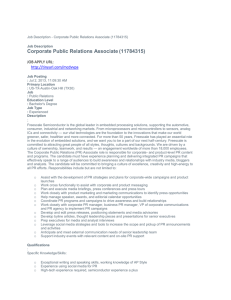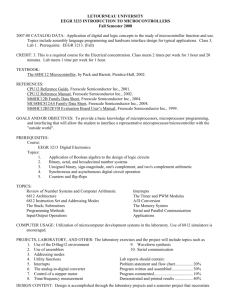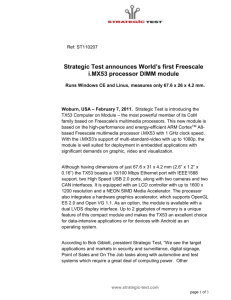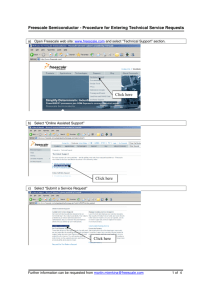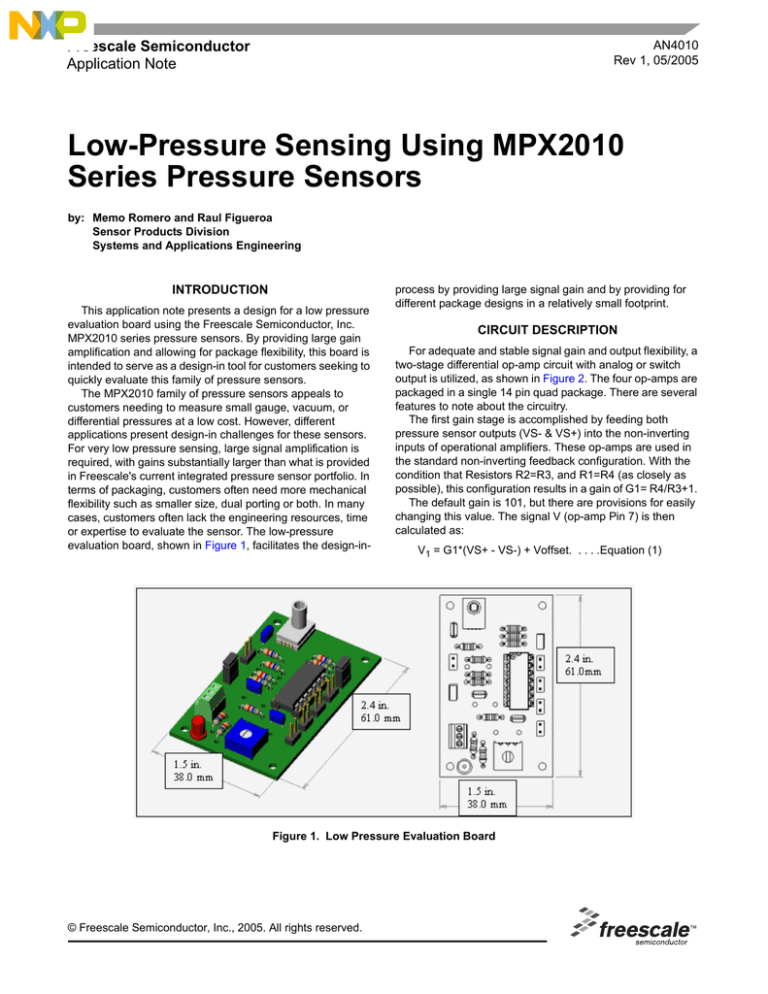
Freescale Semiconductor
Application Note
AN4010
Rev 1, 05/2005
Low-Pressure Sensing Using MPX2010
Series Pressure Sensors
by: Memo Romero and Raul Figueroa
Sensor Products Division
Systems and Applications Engineering
INTRODUCTION
This application note presents a design for a low pressure
evaluation board using the Freescale Semiconductor, Inc.
MPX2010 series pressure sensors. By providing large gain
amplification and allowing for package flexibility, this board is
intended to serve as a design-in tool for customers seeking to
quickly evaluate this family of pressure sensors.
The MPX2010 family of pressure sensors appeals to
customers needing to measure small gauge, vacuum, or
differential pressures at a low cost. However, different
applications present design-in challenges for these sensors.
For very low pressure sensing, large signal amplification is
required, with gains substantially larger than what is provided
in Freescale's current integrated pressure sensor portfolio. In
terms of packaging, customers often need more mechanical
flexibility such as smaller size, dual porting or both. In many
cases, customers often lack the engineering resources, time
or expertise to evaluate the sensor. The low-pressure
evaluation board, shown in Figure 1, facilitates the design-in-
process by providing large signal gain and by providing for
different package designs in a relatively small footprint.
CIRCUIT DESCRIPTION
For adequate and stable signal gain and output flexibility, a
two-stage differential op-amp circuit with analog or switch
output is utilized, as shown in Figure 2. The four op-amps are
packaged in a single 14 pin quad package. There are several
features to note about the circuitry.
The first gain stage is accomplished by feeding both
pressure sensor outputs (VS- & VS+) into the non-inverting
inputs of operational amplifiers. These op-amps are used in
the standard non-inverting feedback configuration. With the
condition that Resistors R2=R3, and R1=R4 (as closely as
possible), this configuration results in a gain of G1= R4/R3+1.
The default gain is 101, but there are provisions for easily
changing this value. The signal V (op-amp Pin 7) is then
calculated as:
V1 = G1*(VS+ - VS-) + Voffset. . . . .Equation (1)
Figure 1. Low Pressure Evaluation Board
© Freescale Semiconductor, Inc., 2005. All rights reserved.
Figure 2. Circuit Schematic
Voffset is the reference voltage for the first op-amp and is
pre-set with a voltage divider from the supply voltage. This
value is set to be 6.7 percent of the supply voltage. It is
important to keep this value relatively small simply because it
too is amplified by the second gain stage. It is also desirable
to have resistors R7 and R8 sufficiently large to reduce power
consumption.
The second gain stage takes the signal from the first gain
stage, V, and feeds it into the non-inverting input of a single
op-amp. This op-amp is also configured with standard noninverting feedback, resulting in a gain of G2=R5/R6+1. The
default value is set to 2, but can easily be changed.
The signal produced at the output of the second stage
amplifier, V (op-amp pin 8) is the fully amplified signal. This is
calculated as
V2 = G2* V1. . . . .Equation (2)
From this point, there are two possible output types
available. One is a simple follower circuit, as shown in
Figure 3, in which the circuit output, Vout (op-amp pin 14), is
essentially a buffered V signal. This analog output option is
available for applications in which the real time nature of the
pressure signal needs to be measured. This option is selected
by connecting jumpers J5 and J6. J4 and J7 are not connected
for analog output.
The second output choice, a switch output as shown in
Figure 4, is accomplished by setting jumpers J4 and J7, and
leaving J5 and J6 unconnected. This is appropriate for
applications in which a switching function is desired. In this
case, the fourth op-amp is configured as a comparator, which
will invert V2, high or low, depending on whether V2 is larger
or smaller than the preset reference signal, set by trim-pot R9.
This signal can be used to simulate a real world threshold.
Figure 3. Analog Output Jumper Settings
Figure 4. Switch Output Jumper Settings
AN4010
2
Sensors
Freescale Semiconductor
Table 1 shows the jumper settings for both analog and
switches outputs.
JP6
JP7
To take an example, suppose that the supply voltage, Vs is
5 volts, and the threshold is set to 60 percent of Vs, or 3 volts.
This corresponds to one leg of the 1K potentiometer set to
0.4K while the other is set to 0.6K. Thus the effective pot
resistance is 0.4K // 0.6K = 0.24K.
In
In
Out
Therefore,
Out
Out
In
Table 1. Output Jumper Settings
Output
JP4
Analog
Out
Switch
In
JP5
For the switch output option, it is desirable to apply some
hysteresis on the output signal to make it relatively immune to
potential noise that may be present in the voltage signal as it
reaches and passes the threshold value. This is accomplished
with feedback resistor R10. From basic op-amp theory, it can
be shown that the amount of hysteresis is computed as
follows:
VH = Vout *[1-(10 / (R10 + R pot-eff))]
Where:
–
–
–
–
VH is the output voltage attenuation, due to
hysteresis, in volts
Vout is the output voltage (railed hi or low)
R10 is the feedback resistor, = 50K
Rpot-eff is the effective potentiometer resistance
VH may vary depending on the particular value of the
potentiometer.
VH = 5V* [1- (50K/(50K + 0.24K))] = 24 mV.
Under these conditions, V signals passing through the
threshold will not cause Vout to oscillate between Vs and
Ground as long as noise and signal variations in V are less
than 24mV during the transition. Figure 5 illustrates the benefit
of having a hysteresis feedback resistor.
GAIN CUSTOMIZATION
The low-pressure evaluation board comes with default
gains for both G1 and G2. G1 is factory set at 101, while G2 is
set to 1. Jumpers JP1, JP2 and JP3 physically connect the
resistors that produce these default gains. Three resistor
sockets (R11, R41 and R51) are provided in parallel with R1,
R4 and R5, respectively. By removing jumpers JP1, JP2 and
JP3, and soldering different resistor values in the appropriate
sockets, different gain values can be achieved. The limit on
the largest overall gain that can be used is determined by opamp saturation. Thus if gain values are chosen such that the
output would be larger than the supply voltage, then the opamp would saturate, and the pressure would not be accurately
reflected. Table 2 outlines the jumper settings for customizing
the gain.
Table 2. Resistor and Jumper Settings for Gain
Customization
Gain
Figure 5. Output Transition without Hysteresis
Resistors
Jumpers
Remarks
G1
G2
R11
R41
R51
JP1
JP2
JP3
101
2
no
load
no
load
no
load
In
In
In
Default
User
Set
2
load
load
no
load
Out
Out
In
R11=R41
101
User
Set
no
load
no
load
load
In
In
Out
User
Set
User
Set
load
load
load
Out
Out
Out
R11=R41
DESIGN CONSIDERATIONS
Since the evaluation board is primarily intended for lowpressure gage and differential applications, large gain values
can be utilized for pressures less than 1.0 kPa. For example
if G1 is set to 101, and G2 set to 6, then the total gain is 606.
Inherent in the MPX2010 family of pressure sensors is a
zero-pressure offset voltage, which can be up to 1 mV. This
offset is amplified by the circuit and appears as a DC offset at
Vout with no pressure applied. The op-amp also has a voltage
offset specification, though for the recommended op-amp this
value is small and does not contribute significantly to the Vout
offset.
Figure 6. Output Transition with Hysteresis
AN4010
Sensors
Freescale Semiconductor
3
For example, if the evaluation board is being used under
the following conditions:
Vs = 3V
G1 = 101
G2 = 6
MPX2010 zero pressure offset = 0.3mV
At this supply voltage, VOFFSET can be calculated to be
6.7% x 3V = 0.2V. The voltage V, due simply to the zero
pressure sensor offset voltage of 0.3mV, can be calculated
from equation (1):
V1 = 0.3mV * 101 + 0.2V = 0.23V
The voltage after the second gain stage comes from
equation (2),
BOARD LAYOUT & CONTENT
The low-pressure evaluation board has been designed
using standard components. The only item that requires
careful selection is the operation amplifier IC. Because the
selected gain may be relatively high as in the previous
example, it is essential that this device have a low offset
voltage. A device with a typical voltage offset of 35 mV has
been selected. Even with a gain of 1500, this will result in a
52mV offset. Table 3 is a parts list for the board layout shown
in Figure 1.
Table 3. Parts List
Qty.
Description
Value
Vendor
Part No.
X1
Ref.
1
Pressure Sensor
10 Kpa
Freescale
MPX2010
MPXC201
1
C1
1
Vcc Cap
1 uF
Generic
C2
1
Op-Amp Cap
0.1 uF
Generic
4700 pF
Generic
V2 = 6 x 0.23V = 1.38 V.
Therefore, before any pressure is applied to the sensor, a
1.38V DC signal will appear at V. Since the supply voltage is
3V, the available signal for actual pressure is 1.62 V. With a
total gain of G1 x G2 = 606, the largest raw pressure signal
that can be accurately measured would be 1.62V/606 = 2.67
mV. For the MPX2010 family operating at Vs = 3V, this
corresponds to roughly 3.5 kPa.
The board lends itself well to system integration via an A/D
converter and microprocessor. For particular applications,
general knowledge of the expected pressure signal can aid in
choosing the proper customized gain. This will avoid op-amp
saturation and will also ensure that the full-scale output signal
is suitable for A/D conversion. To take another example,
suppose that a particular application has the following
constraints:
Supply Voltage, Vs = 5.0 V,
(thus VOFFSET = 6.7% x 5 = 0.335 V)
Sensor zero-pressure offset voltage, VZP = 0.3mV
Expected Pressure range = 0-2 kPa,
(corresponds to ∆VSENSOR-MAX = 2.5mV @ 5V)
Desired maximum output range, ∆V2MAX = 2V
(assume VMIN = 2V, V2MAX = 4V for reasonable
A/D resolution)
By manipulating equations (1) and (2) it can be shown
that,
∆V2MAX = GT x ∆VSENSOR-MAX
C3
1
2nd stage cap
D1
1
LED
Generic
for U1
1
Op-Amp socket
Generic
U1
1
Op-Amp
Analog
Devices
R1, R4
2
1/4 W Resistor
100K
Generic
R2,R3,
R5,R6
4
1/4 W Resistor
1K
Generic
R7
1
1/4 W Resistor
6.8K
Generic
R8
1
1/4 W Resistor
510
Generic
R9
1
Potentiometer
1K
Bourns
R10
1
1/4 W Resistor
51K
Generic
R11
1
1/4 W Resistor
custom
Generic
R12
1
1/4 W Resistor
2K
Generic
R41
1
1/4 W Resistor
custom
Generic
R51
1
1/4 W Resistor
custom
Generic
JP1 JP7
7
Jumper
Generic
J1
1
3 Pos Connector
Phoenix
OP496GP
3386P-102
MKDS1
where GT is the total gain, equal to G1G2.
Thus GT = 2V/2.5mV = 800
To find G1 and G2, evaluate V2MIN at the zero pressure
condition.
V2MIN = G2 V1MIN,
But V1MIN = G1 VZP + VOFFSET
Thus V2MIN = GT VZP + G2 VOFFSET
Solving for G2, G2 = (V2MIN - GT VZP)/ VOFFSET
numerically, G2 = (2V - (800x.0003V))/.335V
G2 = 5.2, and G1 = GT /G2 = 152
AN4010
4
Sensors
Freescale Semiconductor
How to Reach Us:
Home Page:
www.freescale.com
E-mail:
support@freescale.com
USA/Europe or Locations Not Listed:
Freescale Semiconductor
Technical Information Center, CH370
1300 N. Alma School Road
Chandler, Arizona 85224
+1-800-521-6274 or +1-480-768-2130
support@freescale.com
Europe, Middle East, and Africa:
Freescale Halbleiter Deutschland GmbH
Technical Information Center
Schatzbogen 7
81829 Muenchen, Germany
+44 1296 380 456 (English)
+46 8 52200080 (English)
+49 89 92103 559 (German)
+33 1 69 35 48 48 (French)
support@freescale.com
Japan:
Freescale Semiconductor Japan Ltd.
Headquarters
ARCO Tower 15F
1-8-1, Shimo-Meguro, Meguro-ku,
Tokyo 153-0064
Japan
0120 191014 or +81 3 5437 9125
support.japan@freescale.com
Asia/Pacific:
Freescale Semiconductor Hong Kong Ltd.
Technical Information Center
2 Dai King Street
Tai Po Industrial Estate
Tai Po, N.T., Hong Kong
+800 2666 8080
support.asia@freescale.com
For Literature Requests Only:
Freescale Semiconductor Literature Distribution Center
P.O. Box 5405
Denver, Colorado 80217
1-800-441-2447 or 303-675-2140
Fax: 303-675-2150
LDCForFreescaleSemiconductor@hibbertgroup.com
AN4010
Rev. 1
05/2005
Information in this document is provided solely to enable system and software
implementers to use Freescale Semiconductor products. There are no express or
implied copyright licenses granted hereunder to design or fabricate any integrated
circuits or integrated circuits based on the information in this document.
Freescale Semiconductor reserves the right to make changes without further notice to
any products herein. Freescale Semiconductor makes no warranty, representation or
guarantee regarding the suitability of its products for any particular purpose, nor does
Freescale Semiconductor assume any liability arising out of the application or use of any
product or circuit, and specifically disclaims any and all liability, including without
limitation consequential or incidental damages. “Typical” parameters that may be
provided in Freescale Semiconductor data sheets and/or specifications can and do vary
in different applications and actual performance may vary over time. All operating
parameters, including “Typicals”, must be validated for each customer application by
customer’s technical experts. Freescale Semiconductor does not convey any license
under its patent rights nor the rights of others. Freescale Semiconductor products are
not designed, intended, or authorized for use as components in systems intended for
surgical implant into the body, or other applications intended to support or sustain life,
or for any other application in which the failure of the Freescale Semiconductor product
could create a situation where personal injury or death may occur. Should Buyer
purchase or use Freescale Semiconductor products for any such unintended or
unauthorized application, Buyer shall indemnify and hold Freescale Semiconductor and
its officers, employees, subsidiaries, affiliates, and distributors harmless against all
claims, costs, damages, and expenses, and reasonable attorney fees arising out of,
directly or indirectly, any claim of personal injury or death associated with such
unintended or unauthorized use, even if such claim alleges that Freescale
Semiconductor was negligent regarding the design or manufacture of the part.
Freescale™ and the Freescale logo are trademarks of Freescale Semiconductor, Inc.
All other product or service names are the property of their respective owners.
© Freescale Semiconductor, Inc. 2005. All rights reserved.


